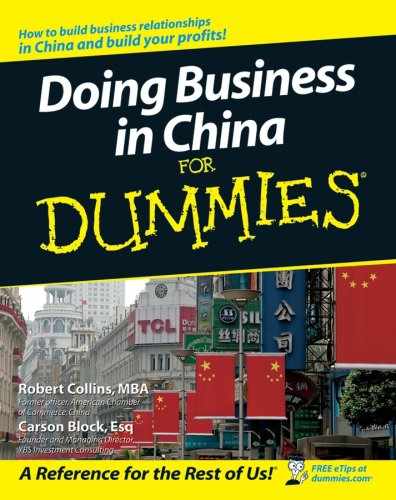Advertising
Chinese consumers are usually receptive to advertising (if done right). However, reaching them through TV and other mass media can be very costly. Fortunately, China offers a number of effective but less expensive advertising alternatives. The following sections tell you how to arrange effective advertising.
Keeping the message simple and obvious
The nice thing for foreign companies advertising in China is that Chinese aren’t as cynical about ads as Westerners are. Advertising in China seems to reflect an age of innocence similar to the post-WWII U.S. There’s little subtlety in conveying the message in advertising in China. Make the message simple and obvious.
Catering to aspirations of wealth
Effective advertising in China often caters to aspirations of obtaining a wealthy, luxurious lifestyle (frequently in a nouveau riche sense) — even for mass-market products. Chinese consumers associate a wealthy lifestyle with images of modern home interiors decorated with designer furniture (often in various shades of white), accessorized with grand pianos and gilded objects.

Advertisements promoting premium products tend to be somewhat over-thetop. Cheryl Chong, a former advertising professional with J. Walter Thompson in Beijing, tells the story of a high-profile campaign she once produced as marketing director for a mobile phone company in China. One commercial featured two top fashion models: One picking up a Van Gogh painting at an art gallery while the other drove away in a flaming red Ferrari.
A commercial for an imported alcoholic spirit features two Chinese men in their 40s arriving at a European castle built on an island in a lake. One man arrives by helicopter, the other comes by limousine. The two step out of their respective modes of transportation and solemnly nod to each other. Each man takes his turn handling a bow and shooting an arrow at a remote target in the middle of the lake. After each hits the bull’s-eye with his first shot, their menservants pour them glasses of the spirit. The commercial closes with the two archers raising their glasses in a tribute to each other.
Choosing advertising features
Here are some points to remember as you try to appeal to your audience:
| ✓ | Chinese consumers generally respond better than Westerners to advertising featuring cutesy kids. |
| ✓ | Celebrity marketing is effective in China (see the earlier section on Chinese and branding). |
| ✓ | Sports and music marketing do all right, but they don’t generate as much traction as in the West. They’re starting to become more effective as Chinese sports and pop culture gathers steam. |
Minding the rules: Good kids and Confucians
Don’t advertise in a way that conflicts with traditional Chinese values. Generally avoid messages of children disobeying their parents (usually a cardinal sin in Confucian societies) or that stress individualism (although this method can be effective in some ads aimed at youth).
Watch out for some legal no-no’s in advertising in China. Advertisers can’t show a woman wearing anything that suggests that she isn’t wearing a bra. They can’t show images of the Chinese flag. And claiming that your product is “the best” or making comparisons to the competition is also impermissible.

Getting the message out
You can reach consumers where they live or work or get consumers to come to you. This section explains your options.
Mass media
Traditional mass media in China is similar to that of anywhere else: television, radio, newspapers, and magazines. To gain traction in mass markets, you either have to have a large share of the advertising voice — in other words, advertise very frequently relative to the competition — or your advertising has to clearly differentiate your offering.
The problem is that TV advertising is fragmented and expensive. The only network with nationwide coverage is China Central Television (CCTV), which has 12 channels. Prime-time spots on CCTV go through a highly competitive annual bidding process. If your company wants these, it’ll have to go up against the likes of Procter & Gamble, which spends over $3 billion in mass media advertising in China per year. Your other choice is to deal with a patchwork of more than 300 TV networks with over 3,000 stations nationwide. Newspapers and magazines are similarly fragmented and expensive unless an advertiser has a large scale.
Out-of-home advertising
For companies that don’t have huge advertising budgets, China is generally ahead of the West for out-of-home advertising opportunities. The best part of out-of-home advertising is that it allows your company to target markets in a cost-effective manner and to reach specific segments of consumers. In addition to billboards, Chinese cities frequently offer video advertising in taxicabs, trains, and elevators. With a captive audience of commuters, these forms of advertising can be pretty effective.

China is also well ahead of the West in another form of out-of-home advertising: SMS (text messages sent to mobile phones). With 450 million mobile phone users, this media platform allows advertisers to send highly-customized messages to the urban communities in each city. eDongcity (www.2288.com), which Cheryl Chong founded, was one of the first providers of SMS content marketing in China, and it continues to be one of the largest.
Another widely used form of out-of-home advertising is event marketing. For instance, high-end brands often hold launch parties. Event marketing and management companies maintain databases of high-end consumers in various markets that you can use to build your guest list.
A similar concept is called roadshow, which is essentially a series of smaller-scale events conducted at high-traffic venues such as shopping mall atriums, public parks, and campus hubs. Roadshows are effective for advertisers who require a live audience to perform product demonstrations.
